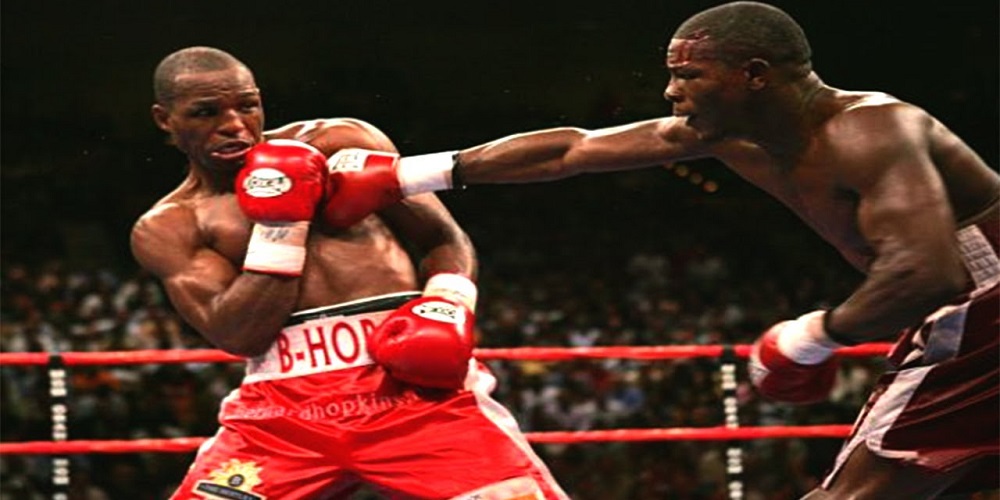Even the longest and most glorious reigns in boxing history eventually come to an end. Sometimes it’s the champion who steps aside, sensing an imminent decline; more often, a young lion hungry for glory takes his place by imposing himself in the ring. The great Bernard Hopkins did not escape this inexorable law: from April 29, 1995, to July 16, 2005, “The Executioner” dominated the middleweight category with twenty title defenses and four belts, but ultimately had to cede the throne to the talented Jermain Taylor. Exactly 19 years after that unexpected passing of the torch, we recount what happened at the MGM Grand in Las Vegas.
Bernard Hopkins’ Winning Decade
It’s not surprising that Hopkins clung to the world title with nails and teeth after finally winning it, considering the tumultuous path that led him to the top. Before becoming a boxer, young Bernard had a rough time, from being stabbed three times in his adolescence to an eighteen-year prison sentence (later reduced to five), to the brutalities of prison, including witnessing an inmate’s murder over a pack of cigarettes. Emerging from that dark world, largely thanks to boxing, The Executioner didn’t have an easy start as a professional. Defeat in his debut nearly pushed him to quit, the failure of his first world title attempt at the hands of Roy Jones Jr. was a bitter pill to swallow, and the tumultuous draw in Ecuador against local idol Segundo Mercado again denied him the coveted title. Therefore, when he finally got his first world title—the IBF belt—Hopkins never stopped, shattering record after record.
Are “Bad Intentions” Enough to Stop the Record Man?
Nicknamed “Bad Intentions” and boasting a good amateur background, including an Olympic bronze medal won in Sydney, Taylor came into his first world title attempt undefeated. However, his chances of victory were not considered high by bookmakers, who had to place their trust in the record man of middleweight history. Hopkins had surpassed Carlos Monzon in the number of defenses, Tommy Ryan in the duration of his reign, and Sugar Ray Robinson in age on the throne: one legend after another was knocked out of the record books, and the elegant but lightly tested Taylor did not seem a sufficient threat to many to interrupt that historic streak of successes. The mistake many observers made on the eve of the Las Vegas showdown was underestimating the stylistic matchup between the fighters. With his speed, self-control, and excellent use of the jab, “Bad Intentions” posed a formidable threat to a boxer like Hopkins, who thrived on counterpunching and was used to giving his best against brawlers.
Challenger’s Masterpiece or Champion’s Miscalculation?
Hopkins’ tactical disadvantage was evident from the early rounds. As expected, The Executioner kept his distance, waiting for the young rival to fall into his trap, but in vain. Taylor, far from wanting to engage in a brawl, wisely kept a safe distance, cautiously using the jab and stepping back at any hint of a counterattack from the more experienced opponent. The challenger’s truly incisive attacks, like the one in the second round that slightly stunned Hopkins, were rare and sporadic, but his work from a distance, although often imprecise, was still preferable to the champion’s disconcerting passivity. Round after round, the fight dragged on sluggishly, with little action, so much so that the accidental headbutt in the fifth round that caused a noticeable cut on Taylor’s head was one of the most notable events of the first two-thirds of the bout. What surprised many about Hopkins, known for his tactical intelligence, was his lack of awareness of the danger: even as he was inexorably falling behind on points, The Executioner continued to ration his attacks and let Taylor dictate the pace.
A Late Comeback That Leaves a Bitter Taste
Only starting from the ninth round did the champion finally show his mettle: with Taylor visibly slowing down, standing more stationary, Hopkins managed to impose close exchanges with good results. The challenger, confused and worn out, had to endure hard blows, was shaken more than once in the tenth round, and finished the fight exhausted. A moving comeback by the decorated 40-year-old from Philadelphia, but insufficient to make up for the lead the challenger had built on the scorecards. The split decision that favored Jermain Taylor was not unanimously accepted, and there were numerous dissenting voices even among boxing journalists. However, the writer believes the verdict was fair, as The Executioner’s reaction, though admirable, vehement, and decisive, had objectively started too late. Nonetheless, the rematch five months later reaffirmed the result of the first fight, this time with unanimous judges.
Often when a rising athlete takes the world title from a veteran of the ring, the former embarks on a successful career while the latter fades away. With Taylor and Hopkins, things went very differently: “Bad Intentions” had a relatively short and unremarkable reign, followed by several harsh defeats; meanwhile, The Executioner, after a sensational double jump in weight class, continued to achieve legendary feats in the light heavyweight division.

